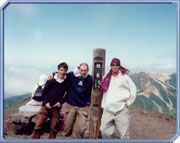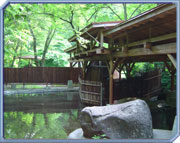 |
 |
 |
Hiking and Hot Spirng Destinations
Japan has plenty to offer the hiking enthusiast be it day-hikes or longer challenging treks. From Tokyo or Osaka, the most accessible destinations are the mountain resorts of Kamikochi, Norikura Kogen, Tateyama or Yudanaka Onsen, all located in the Japan Alps. The scenery is stunning and the hiking trails are well marked and maintained. As well as river side day-hikes and gentle mountain strolls, the area also has a number of longer trekking opportunities. Treks can last from 3 to 6 days and accommodation is in well-equipped mountain huts along the way. The “Mother” of these long hikes runs from Tateyama to Kamikochi and takes a total of 6 days and covers distance of 65km. It traverses the full length of the northern alps and the highest peak is Oku-Hotaka-dake which stands at 3190km. Tateyama, the beginning of the hike and Kamikochi, the end of the hike are mountain resorts with plenty of hot-spring baths where you can soak away any aches and pains.
If you want to venture further off the beaten track, try the rustic pathways of Tohoku (Northern Honshu), the National Park regions of Hokkaido or infrequently trodden paths of Shikoku Island.





Tohoku is one of the lesser visited parts of Honshu and is more sparsely populated than the rest of Japan. The region is dominated by six mountainous prefectures and offers great walking trails and hot-spring resorts. A favourite destination is the hot-spring resort of Naruko Onsen in Miyagi prefecture. Surrounded by mountains, the town is a good base if you want to combine gentle hiking with the therapeutic effects of hot-spring baths. Further to the west the three peaks of the Dewa Sanzen offer a more challenging programme of hiking and temple lodgings.
Even further north is the separate island of Hokkaido which is dominated by 6 national parks and numerous peaks and valleys. Again there are short hikes and longer hiking options as well as opportunities for cycling. The scenery is different to the rest of Japan and some areas are dominated by lush green pastures and rolling hills. Generally Hokkaido sees few visitors and so you can often feel as though you are exploring as yet un-chartered territory and are left free to traverse the wilderness more or less alone.
Shikoku Island lies just off the coast of Hiroshima in western Japan and has long been the site of religious pilgrimage. There are 88 temples on the island and O-henro pilgrims have long followed a clock-wise route around the island hoping to seek enlightenment as Kobo Daishi, founder of the Shingon Sect once did. A few walk (1%), but the less enlightened 99% choose to drive or take a coach tour around the island visiting all the temples. If religious pilgrimage is not your thing, then the island has some excellent inland hikes over the peaks and through quasi-national park territory. The peaks of Tsurugi-san and Ishizuchi-san pose a formidable challenge for all hard-core hikers.
BACK TO TOP
|
|
